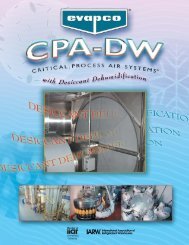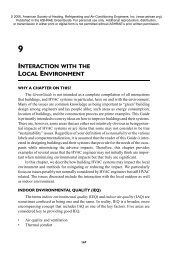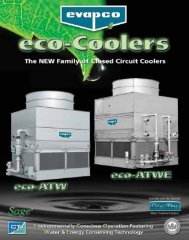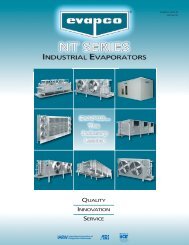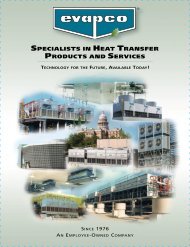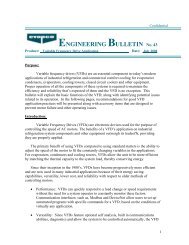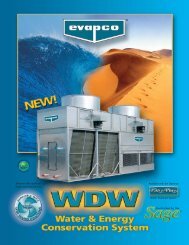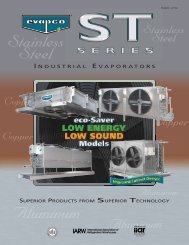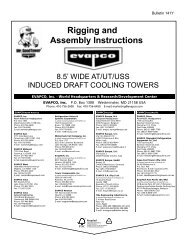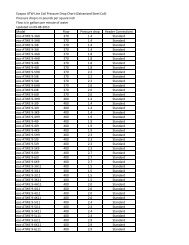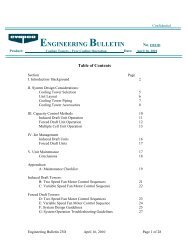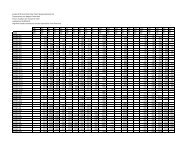Rigging and Installation Manual - Evapco
Rigging and Installation Manual - Evapco
Rigging and Installation Manual - Evapco
Create successful ePaper yourself
Turn your PDF publications into a flip-book with our unique Google optimized e-Paper software.
Low Profile Forced Draft Towers, Coolers <strong>and</strong> Condensers<br />
Method of Shipment<br />
Forced draft units are shipped fully assembled. Miscellaneous items, such as sealer, self-tapping screws <strong>and</strong> any other required<br />
materials, are packaged <strong>and</strong> placed inside the pan for shipment.<br />
NOTE: All hoods <strong>and</strong> attenuation packages are factory inspected prior to shipment to verify proper fit for rigging. Please take extra<br />
care to h<strong>and</strong>le <strong>and</strong> rig unit section per the instructions of this manual to avoid possible distortion <strong>and</strong> poor casing alignment. It is<br />
advisable to check each section upon receipt <strong>and</strong> during each lift to ensure that the factory alignment has not been altered. Should<br />
the field inspection indicate the section alignment (“square”) has been altered, please contact the factory or your local EVAPCO<br />
representative for additional instructions to obtain proper section fit.<br />
Storage<br />
Do not place tarps or other coverings over the top of the units if the units are to be stored before installation. Excessive heat can<br />
build up if the units are covered causing possible damage to the PVC eliminators. For extended storage beyond six months rotate<br />
the fan <strong>and</strong> fan motor shaft(s) monthly. Also, the fan shaft bearings should be purged <strong>and</strong> regreased prior to start-up.<br />
General<br />
For extended lifts, or where hazards may exist, it is recommended that safety slings <strong>and</strong> spreaders be employed for safety. Refer to<br />
the extended lift information in this bulletin.<br />
International Building Code Provisions<br />
The International Building Code (IBC) is a comprehensive set of regulations addressing the structural design <strong>and</strong> installation<br />
requirements for building systems– including HVAC <strong>and</strong> industrial refrigeration equipment. As of June 2008, all 50 states plus<br />
Washington D.C. have adopted the International Building Code. The code provisions require that evaporative cooling equipment<br />
<strong>and</strong> all other components permanently installed on a structure must meet the same seismic design criteria as the building. The<br />
LPT Series Cooling Towers, LR Series Coolers <strong>and</strong> Condensers are IBC 2009 compliant up to 1g with st<strong>and</strong>ard construction <strong>and</strong><br />
up to 5.12g with additional structural modifications.<br />
All items attached to the EVAPCO LPT Cooling Tower, <strong>Evapco</strong> LR Closed Circuit Cooler or LR Evaporative Condenser must be<br />
independently reviewed <strong>and</strong> isolated to meet applicable wind <strong>and</strong> seismic loads. This includes piping, ductwork, conduit, <strong>and</strong><br />
electrical connections. These items must be flexibly attached to the <strong>Evapco</strong> unit so as not to transmit additional loads to the<br />
equipment as a result of seismic or wind forces.<br />
Structural Steel Support<br />
Two structural “I” beams running the length of the unit are required for supporting the unit. These beams should be located<br />
underneath the outer flanges of the unit as shown in Figure 1. See Table 1 for Steel Support Dimensions. Table 1 lists units<br />
according to the nominal plan area of their heat transfer section. Overall dimensions will be different.<br />
Mounting holes, 3/4” in diameter, are located in the bottom flange for bolting to the structural steel. Refer to the recommended<br />
structural steel support drawing <strong>and</strong> certified print for exact bolt hole location. Bolt the bottom section to the steel support before<br />
rigging any hoods or attenuation.<br />
Beams should be sized in accordance with accepted structural practices. Maximum deflection of the beam under the unit should be<br />
1/360 of the unit length, not to exceed 1/2”. Deflection may be calculated by using 55% of the operating weight as a uniform load on<br />
each beam (see certified print for operating weight).<br />
2



